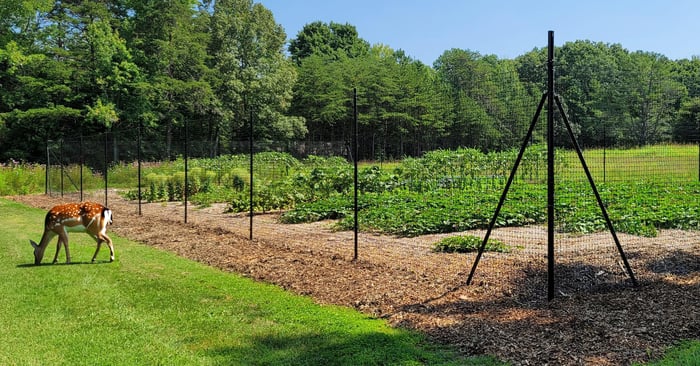
Springtime Preparations: Why You Should Build Your Deer Fence Before Spring
As winter thaws and the first green shoots of spring emerge, a bucolic scene unfolds. Yet, for gardeners and homeowners across the country, a seasonal terror lurks just beyond the flowering hues: deer. With their voracious appetite, these majestic creatures can decimate gardens and landscapes in a matter of days.
In this comprehensive guide, we'll explore the necessity of a deer fence, why putting one up before spring is non-negotiable, the various types of fencing options available, and the value of professional installation versus DIY. If you've ever despaired at the sight of a prize tulip or your meticulously tended tomatoes ravaged overnight, this is a post you won't want to miss.
Understanding the Deer Problem
For those whose hobbies and livelihoods are intertwined with the land, deer can present a significant challenge. The surge in urbanization has led to a decrease in natural habitats for deer, pushing them into suburban and rural areas in search of food.
The Impact of Deer on Gardens and Properties
Deer are selective eaters and have a particular fondness for garden favorites like roses, azaleas, and many vegetables. Their browsing habits can lead to significant loss, both in terms of the immediate damage to plants and the distressing long-term impact on the environment.
The Statistics on Deer-related Damage
The severity of the problem is evident in the numbers. According to the United States Department of Agriculture (USDA), deer are responsible for approximately $1.5 billion in damage to crops and property each year. These figures are a sharp reminder of the need for proactive deer management strategies.
Benefits of Building a Deer Fence
The primary purpose of a deer fence, of course, is protection. It serves as a physical barrier, preventing deer from accessing the areas it encloses. But the benefits go beyond simple exclusion.
Protection for Plants and Crops
A well-constructed deer fence guards against the indiscriminate grazing of ornamental plants and the loss of precious vegetable and fruit yields. In an era where sustainable food production is of growing interest, protecting one's crops is more than an aesthetic concern; it's an economic and ethical choice.
Prevention of Property Damage
Deer are known to stray into roads, causing accidents, and into yards, where they can compromise the integrity of both natural and manmade structures. By setting up a deer fence, homeowners can protect their land and reduce the risk of damage.
Reduction of Deer-related Diseases
Deer carry ticks that can transmit Lyme disease, which can have severe health implications for humans and pets. By minimizing the interaction between people and deer, a fence also minimizes the risk of tick-borne illnesses.
Timing Matters: Why Before Spring?
Spring is a crucial time for deer and, consequently, for those seeking to manage their presence. As the weather warms, deer enter a phase of increased activity and dietary needs. This is compounded by the fact that spring is the breeding season, or "rut," when deer are known to be more on the move than any other time of year.
Deer Behavior During Springtime
The surge in deer activity makes it more challenging to deter them once they've established a pattern of raiding gardens and foraging. Additionally, with rut comes recklessness; deer, particularly males, are less cautious than usual, further heightening the risk of damage.
Importance of Installing the Fence Before Deer Breeding Season
By installing your deer fence prior to the onset of spring, you catch the animals off-guard, disrupting their ability to freely roam and feed. This, in turn, can help establish your property as an unfruitful territory, leading the deer to seek sustenance elsewhere.
Types of Deer Fencing
The range of options available can be overwhelming, from lightweight plastic deer netting to sturdy metal structures. Each has its strengths and fits particular needs.
Overview of Different Types of Deer Fencing
The most common types of deer fencing include:
- Plastic mesh fences: relatively inexpensive and straightforward to install. Perfect for temporary spaces or a cost-effective solution.
- Metal mesh fences: a more robust solution that also offers a degree of protection against smaller animals. Ideal for long-term use.
- Electric fences: an effective deterrent with the added benefit of training deer to avoid your property over time.
Pros and Cons of Each Option
Consider the longevity, cost, and visibility of the material. For large properties or agricultural areas, electric or metal mesh fences may be the most practical. However, in smaller spaces, plastic fence might be the better choice.
DIY vs. Professional Installation
The decision between installing a deer fence yourself or enlisting the help of professionals is a significant one and should be informed by the scale of the project, your skill level, and your budget.
With the right preparation and some elbow grease, DIY installation can save money and give you a sense of accomplishment. Be sure to measure your property accurately, choose the right materials, and closely follow installation guides to avoid costly mistakes. However, for larger properties and more complex fencing needs, it may be best to leave the job to experienced professionals.
Beating Bambi: The Harrison Family Garden Triumph
In the rolling hills of Virginia, the Harrison family faced an escalating battle against deer in their expansive vegetable garden. Despite trying various repellents, their efforts were in vain until they installed a 7-foot-tall DeerBusters Welded Wire fence kit. Within the first growing season post-installation, the results were remarkable. Previously plundered tomato plants and nibbled young shoots of lettuce were untouched and flourishing. The family's garden yield doubled, providing enough produce to supply their table and share with neighbors. The fence system's discreet appearance and durability blended seamlessly with their pastoral landscape, maintaining the garden's aesthetic. The Harrisons are thrilled, as they can finally enjoy the fruits of their labor without the heartache of deer damage.
Conclusion
As we've explored, a deer fence is a crucial tool for the stewardship of our gardens and properties. With spring looming and the promise of renewal in the air, now is the time to act. Installation is a low-cost, high-value proposition that pays dividends in personal satisfaction, environmental conservation, and economic security.
Recap of the Importance of Building a Deer Fence Before Spring
Spring is the season of growth and life, but it's also a period of heightened vulnerability to deer damage. Building a deer fence before the rush of spring is the proactive step needed to safeguard your space and uphold your values as a gardener and homeowner.
Be inspired by the urgency of the season and make the commitment to a deer fence today with DeerBusters. Your landscape—and, perhaps, your sanity—will thank you.

